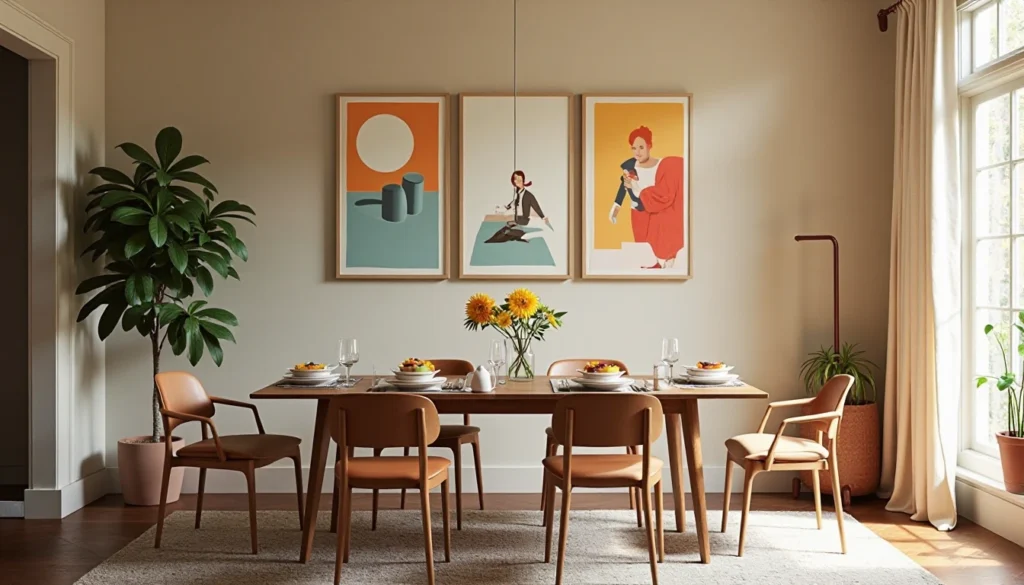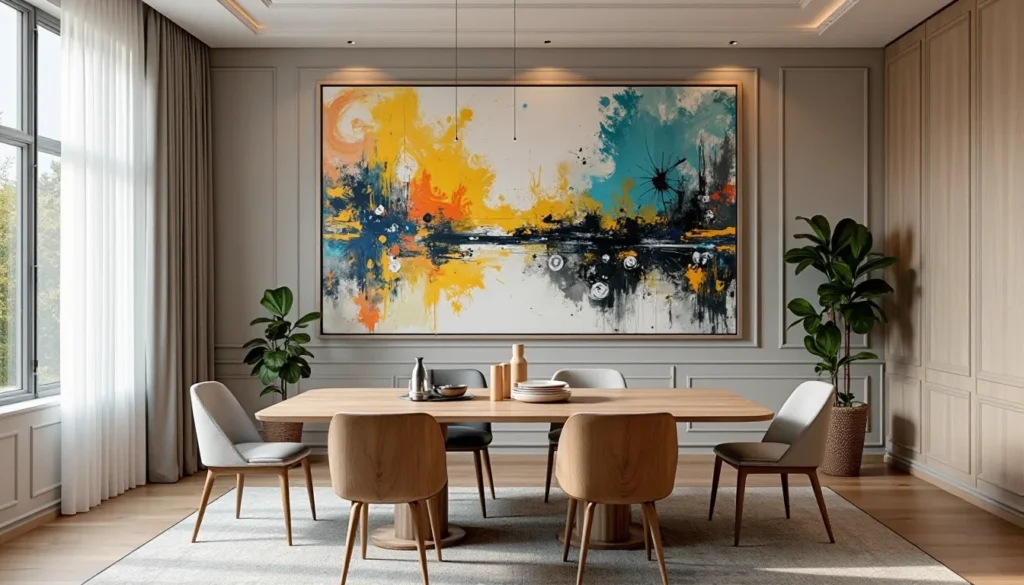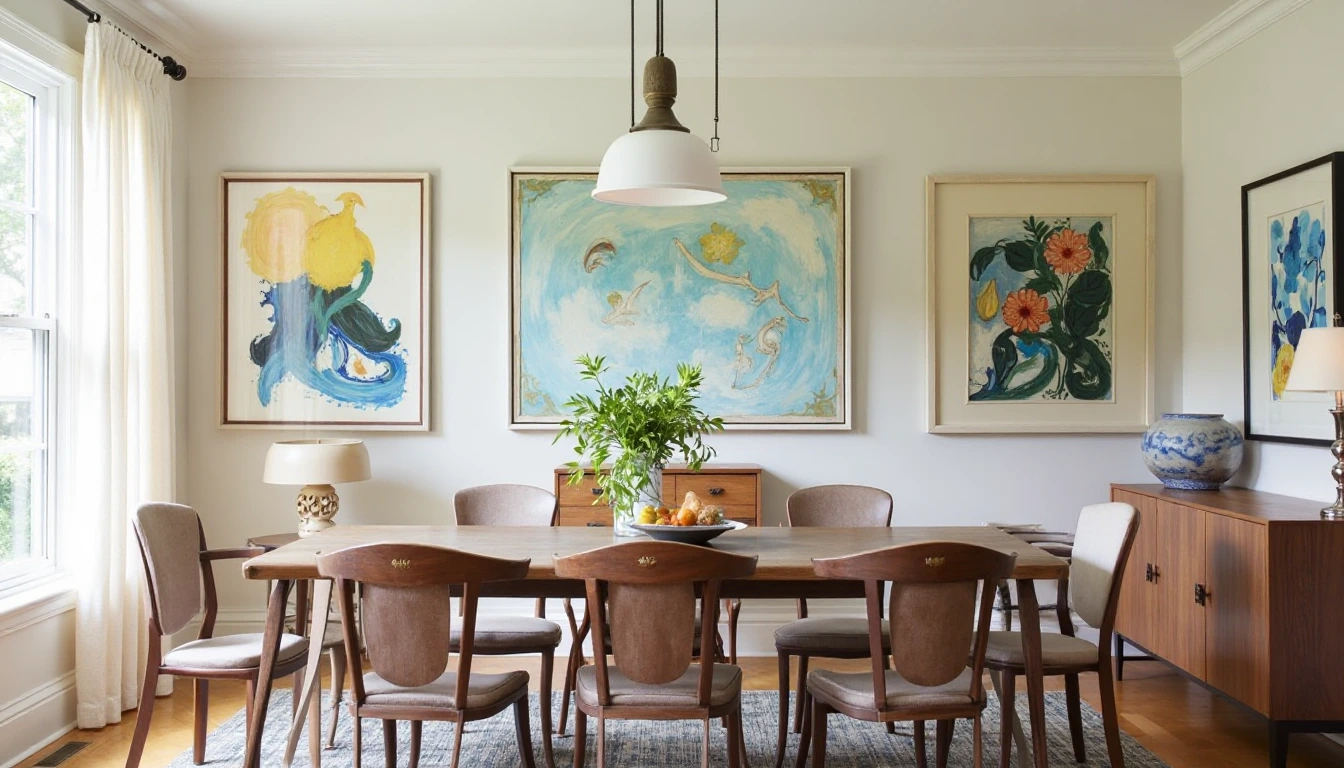Dining Room Wall Art: Master Tips to Elevate Your Space (2025)
Your dining room is more than just a place to enjoy meals—it’s a gathering space where memories are made, conversations flow, and connections deepen. While you may have invested time selecting the perfect table, chairs, and lighting fixtures, dining room wall art often remains an afterthought. Yet, this crucial design element can transform your space from merely functional to absolutely extraordinary.
In this comprehensive guide, we’ll explore how the right dining room wall art can dramatically enhance your space, the various types available, how to select pieces that resonate with your style, and practical tips for arrangement and installation. Whether you prefer dining room modern art that makes a bold statement or traditional pieces that evoke warmth and nostalgia, this article will help you curate a dining area that reflects your personality and enhances your dining experience.
Table of Contents
Why Wall Art Matters in Your Dining Room
The dining room often serves as both an everyday eating space and an entertainment hub for special gatherings. Well-chosen dining room wall art doesn’t just fill empty wall space—it establishes atmosphere, stimulates conversation, and completes your interior design vision.
“The right piece of art in a dining room creates a focal point that elevates the entire space from ordinary to extraordinary.” — Sarah Henderson, Interior Design Specialist
Wall art in the dining area can:
- Set the mood for memorable dining experiences
- Express your personality and taste
- Tie together color schemes and design elements
- Create visual interest in an otherwise functional space
- Stimulate conversation among guests
- Make the room feel more complete and intentionally designed
A 2024 interior design survey revealed that 78% of homeowners believe that dining room wall decor significantly impacts how they feel while dining, with appropriate art selections increasing both appetite and conversation quality.
Popular Types of Wall Art for Dining Rooms

When considering types of wall art for dining room spaces, the options are more diverse than you might initially imagine. Each variety brings different energy and aesthetic appeal to your dining environment.
Canvas Paintings
Canvas paintings remain a timeless choice for dining room walls. From abstract expressionism to landscapes to still lifes of food and wine, paintings can establish your dining room’s color palette and mood.
Best for: Creating a strong focal point and adding texture to the space
Photography
Large-scale photography can bring drama and conversation starters to your dining area. Consider food photography, travel scenes, or black-and-white artistic prints.
Best for: Modern dining rooms and spaces that aim for a clean, contemporary feel
Wall Sculptures
Three-dimensional wall sculptures add texture and unexpected visual interest to dining spaces. Metal, wood, or mixed media sculptures can create fascinating shadow effects when properly lit.
Best for: Adding texture and dimension to minimalist dining rooms
Textile Art
Tapestries, macramé wall hangings, and framed textile pieces bring warmth and acoustic benefits to dining rooms, which often have hard surfaces that amplify noise.
Best for: Creating a cozy, inviting atmosphere and improving room acoustics
Mirrors
While not traditional “art,” decorative mirrors can function as artistic elements while making smaller dining rooms appear more spacious and reflecting light around the room.
Best for: Smaller dining rooms or spaces that need more light
Gallery Walls
A curated collection of smaller pieces arranged thoughtfully can tell a story and showcase your personality better than a single large piece.
Best for: Eclectic dining rooms and collectors who want to display multiple pieces
Wall Installations
Custom installations like plate collections, floating shelves with rotating art displays, or lighting fixtures that double as art make for unique dining room wall features.
Selecting the Perfect Dining Room Wall Art

Choosing dining room wall art involves more than just finding a piece you love—it should harmonize with your space and enhance the dining experience.
Consider Your Dining Room’s Purpose
Is your dining room formal or casual? Used daily or primarily for entertaining? The art you select should align with how you use the space:
- Daily family dining: Choose art that’s uplifting and promotes positive energy
- Formal entertaining: Select sophisticated pieces that spark conversation
- Multi-functional spaces: Opt for versatile art that works across different uses
Match Your Interior Design Style
Your dining room wall art should complement your existing decor style:
- Modern/Contemporary: Abstract pieces, black and white photography, or dining room modern art with clean lines and bold colors
- Traditional: Landscapes, still lifes, or classical portraits in ornate frames
- Farmhouse/Rustic: Botanical prints, vintage signs, or primitive folk art
- Mid-Century Modern: Geometric prints, abstract compositions, or retro-inspired pieces
- Minimalist: Single large-scale piece with limited color palette or negative space
- Eclectic: Mix of different styles, sizes, and media that share a common element
Consider the Dining Experience
Remember that people will be viewing your dining room wall art while eating. Some subjects enhance the dining experience, while others might be less appetizing:
Good choices:
- Food and beverage themes (wine, fruit, etc.)
- Landscapes and natural scenes
- Abstract art with harmonious colors
- Calm water scenes
- Botanical illustrations
Consider carefully:
- Portraits with intense gazes
- Politically charged or controversial subjects
- Overly busy or chaotic compositions
- Subjects that might dampen appetite
Size and Placement Guidelines
Proper sizing and placement of dining room wall art can make the difference between a polished look and an awkward arrangement.
Size Considerations
The golden rule for dining room wall art is proportionality:
- For single pieces over a dining table: Choose art that is approximately 2/3 to 3/4 the width of your table
- For pieces on other walls: Scale according to wall size, generally filling 60-75% of available wall space
- For gallery arrangements: Treat the entire arrangement as one unit when considering size proportions
Optimal Placement
- Height: Center your art at eye level when seated (typically 60-65 inches from the floor to the center of the piece)
- Over dining tables: Hang art 6-12 inches above the table surface
- Multiple pieces: Maintain consistent spacing between frames (typically 2-3 inches)
- Lighting: Consider installing picture lights or adjustable ceiling fixtures to properly illuminate your wall art
Common Placement Mistakes to Avoid
- Hanging art too high, especially in dining rooms where people are seated
- Choosing pieces that are too small for the wall
- Overcrowding walls with too many small pieces
- Failing to consider viewing angles from seated positions
Color Theory and Dining Room Wall Art

Color psychology plays a significant role in dining experiences, making your dining room wall art color choices particularly important.
Colors That Enhance Appetite
Research suggests certain colors stimulate appetite and conversation—ideal for dining spaces:
- Red, orange, and yellow tones: Stimulate appetite and energy
- Warm earth tones: Create comfort and encourage lingering at the table
- Green: Associates with freshness and health
Creating Contrast or Harmony
Your wall art can either:
- Contrast with your dining room color scheme for a bold, dramatic statement
- Harmonize with existing colors for a cohesive, sophisticated look
Color Balance Tips
- Use the 60-30-10 rule: 60% dominant color, 30% secondary color, 10% accent color
- Pull one color from your wall art into other room elements (table linens, centerpieces)
- Consider how colors appear under your specific dining room lighting
Dining Room Modern Art Trends (2025)

Contemporary art trends have significantly influenced dining room wall art. Here are the latest trends in dining room modern art for 2025:
Oversized Abstract Expressionism
Large-scale abstract pieces with emotional depth and gestural brushwork create dramatic impact in dining rooms. Look for pieces with:
- Bold, confident brushstrokes
- Unexpected color combinations
- Emotional resonance that enhances conversation
Sustainable and Ethical Art
Contemporary diners increasingly value sustainability in all aspects of home design:
- Artworks made from recycled or sustainable materials
- Pieces by artists with ethical production practices
- Art that references environmental themes subtly
Digital Art and NFTs
Digital frames displaying rotating collections or NFT art are gaining popularity in modern dining rooms:
- LCD screens disguised as traditional frames
- Programmable displays that change with meal types or times of day
- Interactive pieces that respond to sound or movement
Biophilic Art Installations
Bringing elements of nature indoors continues to trend strongly:
- Living walls and preserved moss art
- Botanical-inspired sculptures
- Nature photography with hyper-realistic detail
Textural Minimalism
Modern dining rooms are embracing art with subtle textures and limited color palettes:
- Tone-on-tone textile art
- White-on-white paper sculptures
- Monochromatic pieces with rich textural elements
Budget-Friendly Wall Art Solutions
Beautiful dining room wall art doesn’t have to break the bank. Here are affordable options that still make an impact:
Art Print Sources
- Online art marketplaces: Etsy, Society6, Minted
- Print-on-demand services: Printful, Redbubble
- Public domain art: Download and print high-resolution images from museums and libraries
Framing Tips to Save Money
- Purchase standard-sized art to fit ready-made frames
- Look for second-hand frames at thrift stores and repaint if necessary
- Group inexpensive prints together in identical frames for a high-end look
Alternative Wall Decor Ideas
- Framed wallpaper or fabric samples
- Vintage plates or platters arranged in a pattern
- Shadow boxes with meaningful items
- Maps of places you’ve traveled or hope to visit
- Framed menus from special restaurant experiences
DIY Dining Room Wall Art Ideas
Creating your own dining room wall art adds a personal touch that can’t be purchased. Here are some approachable DIY projects:
Canvas Art Projects
- Abstract pour painting: Create flowing, organic designs with acrylic pouring medium
- Geometric color blocking: Use painter’s tape to create clean-lined designs
- Texture painting: Add modeling paste or other materials for dimensional effects
Photography Projects
- Create a grid of food close-ups from your culinary adventures
- Print and frame black-and-white photos of family gatherings
- Document the changing seasons from a favorite window view
Repurposed Materials
- Frame vintage kitchen utensils or antique silverware
- Create a collage from wine labels from memorable bottles
- Arrange decorative plates in an artistic pattern
Step-by-step instructions for a simple DIY canvas art project:
- Purchase a pre-stretched canvas in your desired size
- Select 3-4 complementary paint colors that match your dining room
- Apply a base coat in your lightest color and let dry
- Use painter’s tape to create geometric sections
- Fill each section with different colors
- Remove tape while paint is still slightly wet
- Add metallic accents or details if desired
- Seal with clear matte medium if using textured techniques
Maintaining and Preserving Your Wall Art
Proper maintenance ensures your dining room wall art remains beautiful for years to come, especially considering the unique challenges of dining environments.
Protecting Art in Dining Areas
Dining rooms present specific challenges for artwork:
- Humidity from cooking and serving
- Food particles and grease in the air
- Temperature fluctuations
- Direct sunlight during day meals
Care Tips by Material
- Canvas paintings: Dust lightly with a soft brush, avoid direct sunlight, consider UV-protective glazing
- Photographs and prints: Use UV-protective glass, keep away from heat sources
- Textiles: Vacuum occasionally with a brush attachment, rotate placement to prevent uneven fading
- Metal art: Dust regularly, apply appropriate metal polish annually
- Mixed media: Follow specific care instructions for component materials
When to Call a Professional
Some situations warrant professional attention:
- Water or food damage to valuable pieces
- Torn canvas or damaged frames
- Significant fading or discoloration
- Mold or mildew development
- Restoration of antique or valuable artwork
Before and After: Wall Art Transformations
Nothing demonstrates the impact of dining room wall art like seeing real transformations. Here are three case studies showing how wall art changed dining spaces:
Case Study 1: The Blank Canvas
Before: A minimalist dining room with white walls, a wooden table, and black chairs looked clean but lacked personality and felt sterile.
After: Adding a large-scale abstract canvas in blues and greens with touches of metallic copper brought the space to life while maintaining its modern aesthetic. The art piece tied together the wood and metal elements already present in the furniture.
Key Takeaway: Even in minimalist spaces, the right piece of dining room wall art can add warmth and dimension without cluttering the design.
Case Study 2: The Traditional Update
Before: A traditional dining room with cherry furniture and burgundy walls felt dark and dated despite quality furnishings.
After: Replacing small, scattered artwork with one oversized contemporary landscape lightened the space while respecting its traditional bones. The art’s colors—soft greens, blues, and whites—inspired new table linens and centerpieces that refreshed the entire room.
Key Takeaway: Contemporary dining room wall art can breathe new life into traditional spaces without requiring complete renovation.
Case Study 3: The Rental Revolution
Before: A rental apartment’s dining area with builder-beige walls and limited modification options felt impersonal and uninspiring.
After: A gallery wall using temporary hanging solutions transformed the space. The collection included framed travel photos, small textile pieces, and a central mirror that reflected light from the window.
Key Takeaway: Temporary, removable solutions for dining room wall art can create significant impact in rental properties without risking security deposits.
FAQs About Dining Room Wall Art
Q: What size should dining room wall art be? A: For art above a dining table, aim for a piece or grouping approximately 2/3 to 3/4 the width of your table. The art should feel proportionate to both the table and the wall.
Q: Is it okay to hang valuable art in the dining room? A: With proper precautions, yes. Consider humidity levels, avoid placing valuable pieces directly above serving areas, and ensure proper framing with UV-protective glass if the room receives significant sunlight.
Q: How high should I hang art in my dining room? A: In dining rooms, art should be hung slightly lower than in other rooms since viewers are typically seated. Center pieces at approximately 60-65 inches from the floor, or 6-12 inches above furniture.
Q: What types of wall art work best in small dining rooms? A: Mirrors can make small dining rooms appear larger. Alternatively, choose art with perspective or depth, like landscapes or seascapes, to create the illusion of space. Avoid cluttering small walls with too many pieces.
Q: How do I choose wall art that complements my dining room furniture? A: Look for art that either picks up colors from your furniture and decor or provides complementary contrast. The style should align with your furnishings—contemporary art with modern furniture, traditional art with classic pieces, etc.
Q: Can I mix different styles of wall art in my dining room? A: Yes, with thoughtful curation. Create unity through consistent framing, a cohesive color palette, or a common theme while varying the styles for an eclectic yet intentional look.
Conclusion
The right dining room wall art does more than decorate—it transforms your dining experience. Whether you prefer bold dining room modern art statements or subtle, traditional pieces, the perfect wall art can elevate meals from basic nutrition to memorable occasions.
Remember that your dining room walls offer a canvas to express your personality, complement your interior design, and create the atmosphere you want for both everyday meals and special gatherings. Take time to select pieces that speak to you and follow proper sizing and placement guidelines for maximum impact.
By thoughtfully selecting and arranging your dining room wall art, you create a space where both food and conversation can flourish. Your walls tell your story—make sure they’re saying what you want.
What type of wall art do you have in your dining room? Share your ideas and photos in the comments below!
About the Author: decorcue is an interior design specialist with over a decade of experience helping homeowners transform their dining spaces through thoughtful design and art selection.



One Comment
Comments are closed.